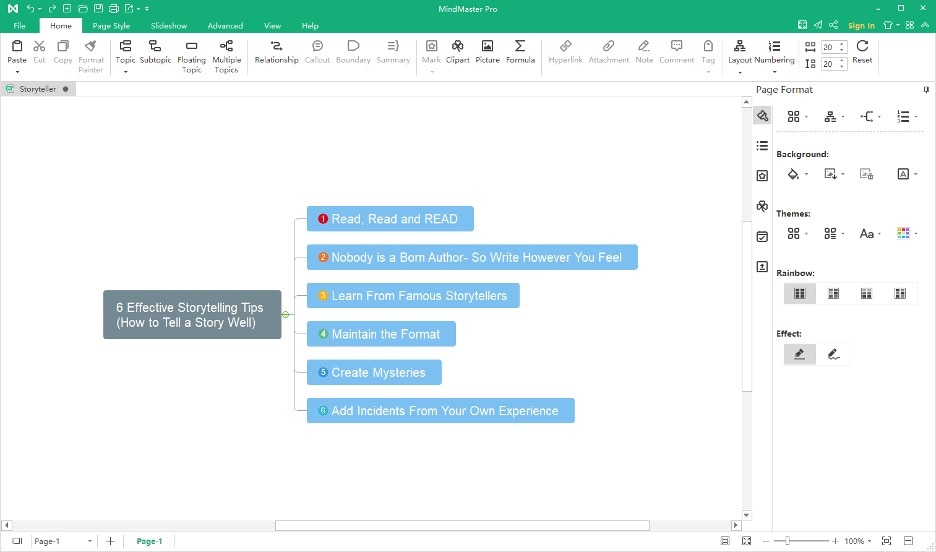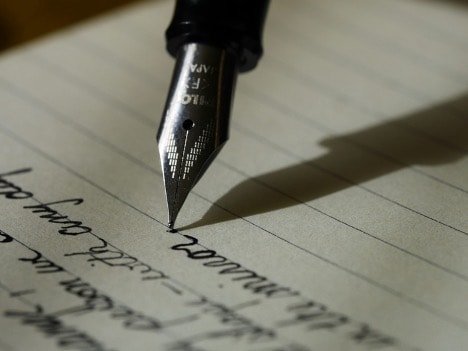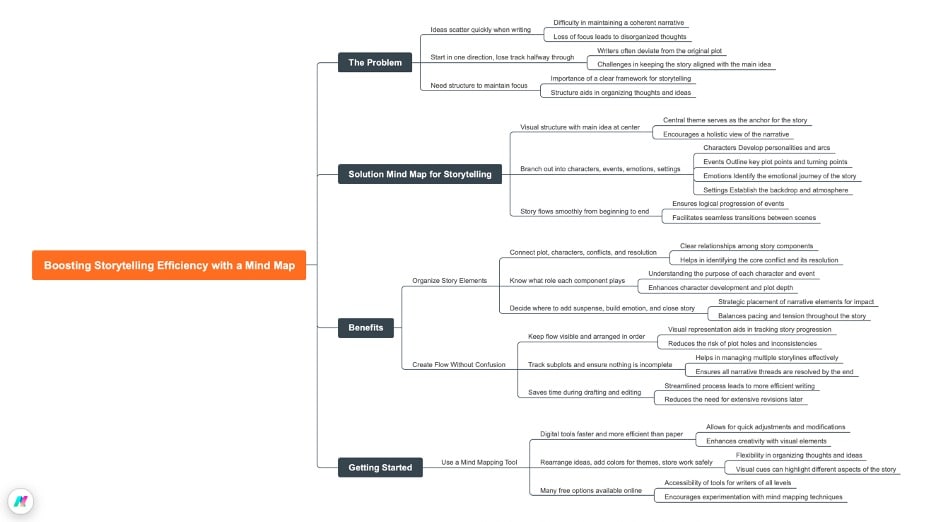It's about your skills to engage your audience. How well you can present your story engages the audience to that extent.
Regardless of the value of the information you provide in the story, if the presentation is not engaging, you cannot connect with your audience. The importance of effective storytelling abilities lies there.
This article will share with you six top secrets, by which you can start creating better stories than before! If you are looking forward to knowing how to tell a story correctly, then keep reading.
Don't expect instant results, as storytelling requires practice. If you follow these six tips regularly, you can slowly start observing improvements in the audience's responses.

In this article
6 Effective Storytelling Tips–How To Tell a Story Well
Here are six effective storytelling tips.
Read, Read and READ
Reading stories, books, novels, and magazines; listening to podcasts; following blogs and social media posts; and engaging with quotes from famous people are all directly proportional to creating great stories. The more you read/listen, the better you become!
Your mind stores whatever you see, read, listen to, and experience when you create something (any creative instances, such as writing or telling stories), which unknowingly reflects in your work.
So, the more high-quality content you read/listen to/ watch, or experience, the more it reflects directly on your creativity. Reading/listening/watching is the foundation of excellent storytelling/story writing.
Nobody Is a Born Author-So Write Whatever You Feel
Many of us struggle to write even a small piece of content or feel shy to come in front and tell stories to others. That's quite natural!
Whenever you do something new, you struggle. But that's the matter that occurs only at the initial phases. When you make storytelling or story writing into habits, there won't be such obstacles anymore!
You will know exactly how to tell a story the right way. So keep writing however you feel, don't be shy. The more you write, the better you become.
It's all about psychology that runs in the background, stopping us from writing even the first story. Don't hesitate, and start it; things will automatically take place. You need to start and maintain a natural writing process. That's all!
Learn From Famous Storytellers: How To Tell a Story Like a Pro
Famous storytellers, who have already learned the skills of engaging readers/listeners and maintaining a huge follower/fan base, can be your mentors. When you are reading this, you must have at least someone who inspires you, whom you follow wholeheartedly.
Start following them more, observe their work, analyze it carefully, and understand every minute detail they provide. Through these points, you'll learn how to tell a story like a pro.
Then note down what exactly you learned from it. Try to implement those tricks while writing your stories. Once you finish writing the whole story, examine whether you have implemented those tricks correctly and identify the areas that need improvement.
This self-analysis is extremely important in the process of becoming a professional storyteller.
Maintain the Format
When you write a story or any content, the format is fundamental to draw the attention of the audience and keep them engaged until the end.
I have mentioned some useful points below, which make your story more readable, engaging, relevant, and enjoyable.
How To Tell a Story- Maintaining Correct Format
- Have a centralized topic based on which the entire story dwells
- The story should have an interesting title.
- There must be an introduction to the story that briefly explains what the reader will read or what the story is about. You need to create an exciting environment here so that the reader gets engaged right at the beginning.
- The story should have the three main parts: the beginning, the middle, and the ending.
- If the middle section consists of multiple incidents/facts, then mention them one by one with separate points.
- Finally, conclude the story on an interesting note; the climax/ conclusion/ ending must differ from others to mark your uniqueness and make you memorable to readers.
Create Mysteries
Readers like mysteries, irrespective of their age—kids, adults, older people—they all connect to mysteries. If it's an adventure, horror, or suspense story, the mystery will come automatically along with the base story.
But when the story is entirely on something else, then it becomes a challenge to create mysteries.
Instead of going away from the main topic, you need to carefully add some mysteries throughout the story to engage the audience till the end.
If you can create mysteries at perfect timing, it will provide punches to the main story, and a story with perfect punches is a sure success.
Add Incidents From Your Own Experience
When telling a story to readers, adding real-life incidents related to the topic of discussion creates more interest!
Readers love to associate themselves with the story they read, and when the author himself describes his own life in the story, it becomes more interesting. It also helps in increasing more followers.
But again, maintain the format, don't get too carried away while creating mysteries or relating real-life incidents. Stick to the main topic and, based on that, make your story.

If you like to write, don't overthink it; start with your very first piece of the story. Even the authors whom you follow, not one of them, became professional in just one day.
Every master was a beginner, and there's nothing wrong with starting something new. Keep learning about how to tell a story online by reading blogs and joining storytelling forums/ groups.
Start with your creation, keep working on it, and you'll surely gather effective storytelling skills. I hope these tips were helpful. For more storytelling tips, keep following the blog. I wish you all the best with your storytelling. Cheers!
Recommend Resources for Storytelling Mastery
Aside from this article, if you want to expand your storytelling prowess, here’s a list of resources that you can use for your next project. These are highly established storytelling resources that you might want to check out.
- For strong narratives. To sharpen your skill in building narratives, try reading Story by Robert McKee or The Writer’s Journey by Christopher Vogler.
- For characters. Characters make up the key parts of your story. Try reading Characters & Viewpoint by Orson Scott Card or The Art of Character by David Corbett.
- For style and language. For language, the book On Writing by Stephen King should be your bible, in addition to Elements of Style by William Strunk Jr. and E.B. White.
There are other aspects of storywriting that you’ll need help with, but as mentioned in the previous section, reading is the actual way to gain more techniques. You should take inspiration from actual successful writers.
The resources provided above might be exhaustive, but they cannot cover everything that you’ll need as a writer.

How To Boost Storytelling Efficiency With a Mind Map
Storytelling may look easy at first glance, but when you begin writing, you often realize how quickly ideas can scatter. You might start with one direction, only to lose track halfway through.
A mind map can solve this challenge. It is a visual structure that allows you to place the main idea at the center and branch out into characters, events, emotions, and settings.
This way, you do not lose focus, and your story flows smoothly from beginning to end.
Organize Story Elements
Every story has multiple elements: the plot, characters, conflicts, and the final resolution. A mind map helps you connect these points so you always know what role each component plays.
When ideas are arranged in this manner, it becomes easier to decide where to add suspense, when to build emotion, and how to close the story satisfyingly.
Create Flow Without Confusion
Often, writers jump from one idea to another without realizing they have skipped important details. With a mind map, the flow remains visible.
You can arrange incidents in order, keep track of subplots, and ensure that no piece is left incomplete. This saves time during both the drafting and editing stages.
Use a Mind Mapping Tool
Although drawing on paper works fine, digital tools are faster and more efficient. They allow you to rearrange ideas, add colors for themes, and store your work safely for later reference. Many free options are available online.
Example: EdrawMind
Wondershare EdrawMind, designed for knowledge management, helps you build story maps quickly and effectively. With templates and collaboration options, it makes storytelling more structured without taking away your creativity.
Before you start writing your story, here are some FAQs and their answers that you might need for extra information/tips:
FAQs
-
1. How do I begin writing a story if I have only a basic idea?
If you have a basic idea of your story, try loading up a mind map in EdrawMind. You’ll start by putting the main idea in the center. Then, write what the story is about in the next branches: setting, characters, time, theme, etc.
From there, you can expand the branches and add in even the flow or roadmap of your story. Please make the most use of mind maps because they can help you build your story part by part.
-
2. How can I make my story more engaging for readers?
It’s tricky to engage your readers. You should know that every person’s interests are different. So, make sure to think about the audience you want to appeal to.
The idea is to sit and write as if you’re reading to your target audience. Do they like a certain type of theme? Word choice? The message is to basically know your audience and really master your craft.
-
3. What should I do if I get stuck in the middle of a story?
It is common to face this problem. One method is to revisit your outline or mind map and check what you want to achieve in the end. Working backward from the conclusion often reveals the missing steps you need to fill. -
4. How detailed should my characters be?
Your characters should feel real, but you do not need to explain every detail. Focus on traits that matter to the story—such as their goals, fears, or relationships. This makes them believable without overwhelming the reader. -
5. How do I improve my storytelling skills over time?
Consistency is the key. Write regularly, even if it is a short piece. Read widely, study different styles, and share your stories for feedback. Each attempt makes you sharper, and slowly, your storytelling becomes more natural.





